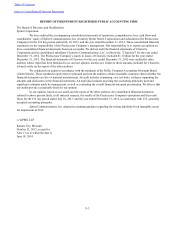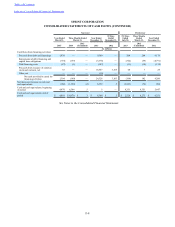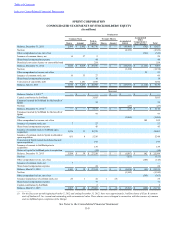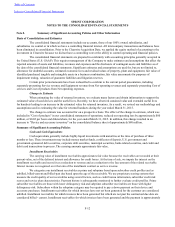Sprint - Nextel 2014 Annual Report Download - page 96
Download and view the complete annual report
Please find page 96 of the 2014 Sprint - Nextel annual report below. You can navigate through the pages in the report by either clicking on the pages listed below, or by using the keyword search tool below to find specific information within the annual report.
Table of Contents
Index to Consolidated Financial Statements
SPRINT CORPORATION
NOTES TO THE CONSOLIDATED FINANCIAL STATEMENTS
F-13
ten days past the contractual due date are considered billed - past due. Account balances are written-off if collection efforts
are unsuccessful and future collection is unlikely based on the length of time from the day accounts become past due.
Allowance for Doubtful Accounts
An allowance for doubtful accounts is established to cover probable and reasonably estimable losses. Because of
the number of subscriber accounts, it is not practical to review the collectability of each of those accounts individually to
determine the amount of allowance for doubtful accounts each period, although some account level analysis is performed
with respect to large wireless and wireline subscribers. The estimate of allowance for doubtful accounts considers a number
of factors, including collection experience, installment billing arrangements, aging of the accounts receivable portfolios,
credit quality of the subscriber base and other qualitative considerations, including macro-economic factors. Account
balances are written-off if collection efforts are unsuccessful and future collection is unlikely based on the length of time
from the day accounts become past due. Amounts written off against the allowance for doubtful accounts, net of recoveries
and other adjustments, were $752 million, $106 million and $98 million for the Successor year ended March 31, 2015, the
three-month transition period ended March 31, 2014 and year ended December 31, 2013, and $374 million, $105 million, and
$549 million, for the Predecessor 191-day period ended July 10, 2013, the unaudited three-month period ended March 31,
2013, and year ended December 31, 2012, respectively. See Note 4. Installment Receivables for additional information as it
relates to the allowance for doubtful accounts specifically attributable to installment receivables.
Device and Accessory Inventory
Inventories are stated at the lower of cost or market. Cost is determined by the first-in, first-out (FIFO) method.
The Company sells wireless devices separately or in conjunction with a service contract. When the device is sold below cost,
the cost and related revenues generated from the device sales (equipment net subsidy) are recognized at the time of sale.
Expected equipment net subsidy is not recognized prior to the time of sale because the promotional discount decision is
generally made at the point of sale and because the equipment net subsidies are expected to be recovered through service
revenues.
The net realizable value of devices and other inventory is analyzed on a regular basis. This analysis includes
assessing obsolescence, sales forecasts, product life cycle, marketplace and other considerations. If assessments regarding the
above factors adversely change, we may sell devices at a higher subsidy or record a write-down to inventory for obsolete or
slow-moving items prior to the point of sale.
Property, Plant and Equipment
Property, plant and equipment (PP&E), including improvements that extend useful lives, are recognized at cost.
Depreciation on property, plant and equipment is generally calculated using the straight-line method based on estimated
economic useful lives of 3 to 30 years for buildings and improvements and network equipment, site costs and related
software and 3 to 12 years for non-network internal use software, office equipment and other. Leasehold improvements are
depreciated over the shorter of the lease term or the estimated useful life of the respective assets. Leased devices are
depreciated using the straight-line method to their estimated residual value at the end of the term of the lease, which ranges
from 12 to 30 months. We calculate depreciation on certain network assets using the group life method. Accordingly, ordinary
asset retirements and disposals on those assets are charged against accumulated depreciation with no gain or loss recognized.
Gains or losses associated with all other asset retirements or disposals are recognized in the consolidated statements of
operations. Depreciation rates for assets are revised periodically to account for changes, if any, related to management's
strategic objectives, technological changes, estimated residual values, or obsolescence. Changes in our estimates will result in
adjustment to depreciation prospectively over the estimated useful lives of our non-leased assets and over the remaining lease
term for devices leased to our customers. Repair and maintenance costs and research and development costs are expensed as
incurred.
We capitalize costs for network and non-network software developed or obtained for internal use during the
application development stage. These costs are included in PP&E and, when the software is placed in service, are depreciated
over estimated useful lives of three to five years. Costs incurred during the preliminary project and post-implementation
stage, as well as maintenance and training costs, are expensed as incurred.
























